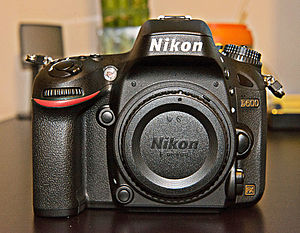Loading AI tools
Digital single-lens reflex camera From Wikipedia, the free encyclopedia
The Nikon D600 is a 24.3-effective-megapixel FX-format full-frame digital SLR camera from Nikon released on September 13, 2012[1] targeted at professionals[2] and enthusiasts.[3] It began shipping on September 18, 2012; at introduction, its suggested retail price in the U.S. was $2099 (UK £1,955) for the body only and $2699 (UK £2,450) with a 24–85 mm kit lens.[1] The Nikon D600 was given a Gold Award by Digital Photography Review.[4]
 | |
| Overview | |
|---|---|
| Type | Digital single-lens reflex |
| Released | 13 September 2012 |
| Intro price | US$ 2099 (body only); US$ 2699 (with 24–85 mm kit lens) |
| Lens | |
| Lens mount | Nikon F-mount |
| Sensor/medium | |
| Sensor type | CMOS |
| Sensor size | 35.9 x 24 mm Full Frame FX format, 5.95 μm pixel size |
| Maximum resolution | 6016 × 4016 (24.3 megapixels) |
| Film speed | 100–6400, extended mode to 50–12800, HI2 mode 25600 |
| Recording medium | Dual SD, SDHC, SDXC. Also UHS-I and Eye-Fi (WLAN) |
| Focusing | |
| Focus modes | Instant single-servo (AF-S); continuous-servo (AF-C); auto AF-S/AF-C selection (AF-A); manual (M) |
| Focus areas | 39-point AF/11-point AF |
| Exposure/metering | |
| Exposure metering | TTL 3D Color Matrix Metering II metering with a 2,016 pixel RGB sensor |
| Metering modes | Matrix metering, center-weighted metering, spot metering |
| Flash | |
| Flash | Manual pop-up; guide number 12/39 at ISO 100 (m/ft) |
| Flash bracketing | -3 to +3 EV in increments of 1/3, 1/2, 2/3, or 1 EV |
| Shutter | |
| Frame rate | 5.5 fps |
| Shutter | Electronically controlled vertical-travel focal-plane shutter |
| Shutter speed range | 1/4000 to 30 sec, bulb, X-sync at 1/200 sec. |
| Viewfinder | |
| Viewfinder | Optical pentaprism, 100% coverage |
| General | |
| LCD screen | 3.2 inch (921,600 dots) |
| Dimensions | 141 x 113 x 82 mm |
| Weight | 760 g (27 oz), body only |
| Made in | |
| Chronology | |
| Successor | Nikon D610 |
According to Nikon the D600 uses the same Expeed 3 as used for the D4 and D800 series, with the same 12-channel sensor interface,[5][6] featuring a very wide dynamic range which provides the possibility of lightening shadows or darkening overlit areas (high dynamic range imaging, HDR) with one shot when shooting in raw image format.[7]
DxOMark reviewed the D600 sensor image quality[7] and assigned it an overall score of 94, the third-highest-rated camera sensor in its camera sensor database, behind the D800 and its sibling, the Nikon D800E.
According to Digital Photography Review, its build quality and user interface are between the D7000 and the high-end full-frame D800. It includes almost all of the video capabilities of the D800, except that the D600 body cannot adjust aperture during video recording.[1]
Following complaints of dust accumulation on the D600's sensor,[9] in late November 2012, a user created a timelapse video as evidence that was then widely reported in photography-related publications.[10][11][12] Three months later, Nikon responded with a service advisory that referred to "the natural accumulation of dust", and advised users to perform "manual cleaning using a blower bulb" before contacting a service center.[13]
On October 8, 2013, the Nikon D610 was announced,[14] a direct successor of the D600, and the D600 was shortly thereafter noted as having been discontinued.[15] The D610 has been described as "a very minor refresh", but does include a new shutter unit.[16] It was speculated that the D610 was released solely to address the oil and dust issues of the D600.[17][18][19]
In January 2014, the website Nikon Rumors reported that some users were receiving D610 units back in response to sending their D600 units in for repair,[20] and Nikon responded by stating this was done on a case-by-case basis.[21] On February 26, Nikon issued another service advisory according to which they will perform full inspection, cleaning, and replacement of the shutter unit for all D600 units sent in, regardless of warranty status, and free of charge.[22] On March 18, the Chinese government ordered Nikon to stop selling the D600, forcing Nikon to recall all remaining units from dealers.[23] Ten days later, Nikon published a third advisory noting that "Nikon will replace [...] with a new D600 or an equivalent model" any cameras "upon which the above service has been performed several times" "if a number of multiple (sic) granular black spots are still noticeable".[24] On June 30, it was revealed Nikon had allocated 1.8 billion Yen (17.6 million USD) for the cost of these repairs and replacements over the past financial year.[25]
Seamless Wikipedia browsing. On steroids.
Every time you click a link to Wikipedia, Wiktionary or Wikiquote in your browser's search results, it will show the modern Wikiwand interface.
Wikiwand extension is a five stars, simple, with minimum permission required to keep your browsing private, safe and transparent.